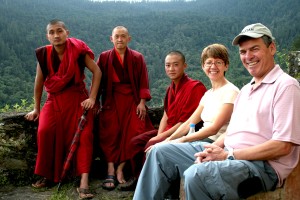A SLOW START FOR BHUTAN TOURISM
A bleak tourist season to begin with?
Most tour operators and hoteliers witnessed a drop in arrivals this spring
If the spring season is an indication of the international tourist arrivals in the country, the tourism industry is not in for a good year with the numbers not encouraging in the first quarter, from January to March.
Most tour operators recorded a drop in international tourist arrivals this spring season while hotels are complaining of low occupancy.
Tourism Council of Bhutan refused to share the arrival figures, but tour operators and hoteliers said that there is not much improvement in arrivals this year compared with the same period last year.
Last year was no better. Despite rigorous marketing and promotional activities, the visit Bhutan year last year recorded a drop in international tourist arrivals. It dropped by about 12 percent with about 51,000 arrivals. In 2014, the country recorded 58,022 international tourists.
A tour operator said spring was not encouraging for his company. “We used to get visitors from Europe in spring but this time, we didn’t,” he said. “As we’ve been marketing the Japanese offer, we expect a slight increase in arrivals during the offer period.”
The ongoing Paro tshechu, according to tour operators, failed to draw tourists unlike the previous years. There were more cancellations from Japanese tourists who have postponed their trip to avail the offer.
“2016 will not be better than last year. There could be a slight increase in arrivals given the Japanese offer but not in terms of yield,” another tour operator said.
Some tour operators attributed the drop this season to the negative feedback by tourists on the road conditions. “We received complaints from our counterpart tour agents to whom tourists complained of the bad road condition from Thimphu to Bumthang,” a tour operator said. “Hopefully international tourist arrivals should pick from 2018 onwards.”
Some tour operators and hoteliers are relying on the Japanese offer that was launched early this year. As part of the offer, Japanese tourists visiting Bhutan during the months of May, June and July will not have to pay the mandatory minimum daily package rate of USD 200 per person. They will only pay the daily royalty of USD 65 per person per night.
The offer is to commemorate 30 years of diplomatic ties between the two countries. The offer includes 50 percent discount on airfare besides discount of up to 50 percent on the hotels.
Hotel Druk’s general manager in Thimphu, Dilu Giri said they recorded a drop in arrivals in the first quarter of this year compared to the previous years. “We are hopeful that the situation will improve by April or May,” Dilu Giri, who is also the vice chairman of Hotel and Restaurant Association of Bhutan, said.
When asked if the Japanese offer would improve occupancy for hotels, Dilu Giri said they are hopeful that the offer would benefit all tourism stakeholders. “Not just hoteliers,” he said.
A Paro hotelier said there was a drop in bookings even for the Paro tshechu. “Business has slowed down this year,” she said, not sure of reasons behind the drop.
Similarly, Guides Association of Bhutan’s (GAB) chairman Garab Dorji said many guides especially the freelancers were not employed this season. During peak seasons, GAB usually arranges freelance guides for tour operators when the demand soars.
“Guides visiting our office have been inquiring about tours,” he said. “Some have not even handled a single group so far.”
Garab Dorji attributed the drop to the Nepal earthquake last year. “As an expensive destination, international tourists have to plan well ahead to visit Bhutan, which they combine with other destinations like Nepal and India.”
Source: Kinga Dema

